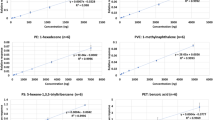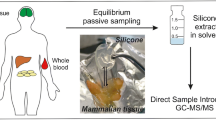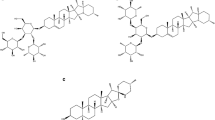Abstract
Food contact materials (FCM) polyethylene terephthalate (PET) and polybutylene terephthalate (PBT) used extensively in food packaging may contain cyclic oligomers which may migrate into food and thus cause toxic effects on human health. A simple, fast, and sensitive ultra-high-performance liquid chromatography method quadrupole time-of-flight mass spectrometer was developed for the analysis of 7 cyclic oligomers in post-mortem blood samples. The targeted analytes were separated on a Waters BEH C18 (150 × 2.1 mm, 1.7 µm) analytical column by gradient elution. Calibration curves were constructed based on standard solutions and blood samples and Student’s t-test was applied to evaluate the matrix effect. The LODs ranged from 1.7 to 16.7 μg mL−1, while the method accuracy was assessed by recovery experiments and resulting within the range 84.2–114.6%. Such an analytical method for the determination of PET and PBT cyclic oligomers in biological samples is reported for the first time. The developed methodology allows the determination of these oligomers in blood providing a useful analytical tool to assess the exposure and thus the potential hazard and health risks associated with these non-intentionally added substances (NIAS) from PET and PBT FCM through food consumption. The method was validated and successfully applied to the analysis of 34 post-mortem whole blood samples. Polyethylene terephthalate trimer was detected in four of them, for the first time in literature.
Graphical abstract



Similar content being viewed by others
References
Lopes JA, Tsochatzis ED, Karasek L, Hoekstra EJ, Emons H. Analysis of PBT and PET cyclic oligomers in extracts of coffee capsules and food simulants by a HPLC-UV / FLD method. Food Chem. 2021;345:128739. https://doi.org/10.1016/j.foodchem.2020.128739.
Tsochatzis ED, Lopes JA, Holland MV, Reniero F, Emons H, Guillou C. Isolation, characterization and structural elucidation of polybutylene terephthalate cyclic oligomers and purity assessment using a 1H qNMR method. Polymers (Basel). 2019;11:1–13. https://doi.org/10.3390/polym11030464.
Piccinini P, Senaldi C, Lopes JFA (2013) Fibre labelling polytrimethylene terephthalate - PTT- DuPonthttps://doi.org/10.2788/34915
Hoppe M, Fornari R, de Voogt P, Franz R. Migration of oligomers from PET: determination of diffusion coefficients and comparison of experimental versus modelled migration. Food Addit Contam Part A Chem Anal Control Expo Risk Assess. 2017;34:1251–60. https://doi.org/10.1080/19440049.2017.1322222.
Tsochatzis E, Dehouck P, Lopes JA, Emteborg H, Robouch E, Hoekstra E. Determination of PBT cyclic oligomers in and migrated from food contact materials-FCM-19/01 Proficiency Testing Report. JRC Technical Reports. 2019; JRC118572, Ispra, European Commission.
Ubeda S, Aznar M, Nerín C. Determination of oligomers in virgin and recycled polyethylene terephthalate (PET) samples by UPLC-MS-QTOF. Anal Bioanal Chem. 2018;410:2377–84. https://doi.org/10.1007/s00216-018-0902-4.
Muncke J, Backhaus T, Geueke B, Maffini MV, Martin OV, Myers JP, Soto AM, Trasande L, Trier X, Scheringer M. Scientific challenges in the risk assessment of food contact materials. Environ Health Perspect. 2017;125:1–9. https://doi.org/10.1289/EHP644.
Brenz F, Linke S, Simat T. Linear and cyclic oligomers in polybutylene terephthalate for food contact materials. Food Addit Contam Part A Chem Anal Control Expo Risk Assess. 2018;35:583–98. https://doi.org/10.1080/19440049.2017.1414958.
Kubicova M, Eckardt M, Simat TJ. Polybutylenterephthalat (PBT) im Lebensmittelkontakt: Migrationspotential von oligomeren Verbindungen. Lebensmittelchemie. 2019;73:1–2. https://doi.org/10.1002/lemi.201951018.
Tsochatzis ED, Alberto Lopes J, Dehouck P, Robouch P, Hoekstra E. Proficiency test on the determination of polyethylene and polybutylene terephthalate cyclic oligomers in a food simulant. Food Packag Shelf Life. 2020;23:100441. https://doi.org/10.1016/j.fpsl.2019.100441.
Alberto Lopes J, Tsochatzis ED, Robouch P, Hoekstra E. Influence of pre-heating of food contact polypropylene cups on its physical structure and on the migration of additives. Food Packag Shelf Life. 2019;20:100305. https://doi.org/10.1016/j.fpsl.2019.100305.
Dehouck P, Tsochatzis ED, Lopes JA, Cizek-Stroh A, Robouch P, Hoekstra EJ. Determination of the mass fractions of PBT and PET oligomers in food simulant D1-FCM-18-01 Proficiency Test Report. JRC Validated methods, Reference Methods and Measurements Report. 2018; JRC113664, Ispra, European Commission.
Muncke J, Andersson AM, Backhaus T, Boucher JM, Carney Almroth B, Castillo Castillo A, Chevrier J, Demeneix BA, Emmanuel JA, Fini JB, Gee D, Geueke B, Groh K, Heindel JJ, Houlihan J, Kassotis CD, Kwiatkowski CF, Lefferts LY, Maffini MV, Martin OV, Myers JP, Nadal A, Nerin C, Pelch KE, Fernández SR, Sargis RM, Soto AM, Trasande L, Vandenberg LN, Wagner M, Wu C, Zoeller RT, Scheringer M. Impacts of food contact chemicals on human health: a consensus statement. Environ Heal A Glob Access Sci Source. 2020;19:1–12. https://doi.org/10.1186/s12940-020-0572-5.
Cramer GM, Ford RA, Hall RL. Estimation of toxic hazard-a decision tree approach. Food Cosmet Toxicol. 1976;16:255–76. https://doi.org/10.1016/S0015-6264(76)80522-6.
Tsochatzis ED, Alberto Lopes J, Kappenstein O, Tietz T, Hoekstra EJ. Quantification of PET cyclic and linear oligomers in teabags by a validated LC-MS method – in silico toxicity assessment and consumer’s exposure. Food Chem. 2020;317:126427. https://doi.org/10.1016/j.foodchem.2020.126427.
Ubeda S, Aznar M, Alfaro P, Nerín C. Migration of oligomers from a food contact biopolymer based on polylactic acid (PLA) and polyester. Anal Bioanal Chem. 2019;411:3521–32. https://doi.org/10.1007/s00216-019-01831-0.
Eckardt M, Schneider J, Simat TJ. In vitro intestinal digestibility of cyclic aromatic polyester oligomers from polyethylene terephthalate (PET) and polybutylene terephthalate (PBT). Food Addit Contam Part A Chem Anal Control Expo Risk Assess. 2019;36:1882–94. https://doi.org/10.1080/19440049.2019.1658903.
Begley TH, Dennison JL, Hollifield HC. Migration into food of polyethylene terephthalate (Pet) cyclic oligomers from pet microwave susceptor packaging. Food Addit Contam. 1990;7:797–803. https://doi.org/10.1080/02652039009373941.
Isella F, Canellas E, Bosetti O, Nerin C. Migration of non intentionally added substances from adhesives by UPLC-Q-TOF/MS and the role of EVOH to avoid migration in multilayer packaging materials. J Mass Spectrom. 2013;48:430–7. https://doi.org/10.1002/jms.3165.
Kim DJ, Lee KT. Determination of monomers and oligomers in polyethylene terephthalate trays and bottles for food use by using high performance liquid chromatography- electrospray ionization-mass spectrometry. Polym Test. 2012;31:490–9. https://doi.org/10.1016/j.polymertesting.2012.02.001.
Lim BH, Kwon SH, Kang EC, Park H, Lee HW, Kim WG. Isolation and identification of cyclic oligomers of the poly(ethylene terephthalate)-poly(ethylene isophthalate) copolymer. J Polym Sci Part A Polym Chem. 2003;41:881–9. https://doi.org/10.1002/pola.10637.
Tsochatzis ED, Alberto Lopes J, Gika H, Kastrup Dalsgaard T, Theodoridis G. Development and validation of an UHPLC-qTOF-MS method for the quantification of cyclic polyesters oligomers in pasta by applying a modified QuEChERS clean-up. Food Chem. 2021;347:129040. https://doi.org/10.1016/j.foodchem.2021.129040.
Ubeda S, Aznar M, Rosenmai AK, Vinggaard AM, Nerín C. Migration studies and toxicity evaluation of cyclic polyesters oligomers from food packaging adhesives. Food Chem. 2020;311:125918. https://doi.org/10.1016/j.foodchem.2019.125918.
Úbeda S, Aznar M, Vera P, Nerín C, Henríquez L, Taborda L, Restrepo C. Overall and specific migration from multilayer high barrier food contact materials–kinetic study of cyclic polyester oligomers migration. Food Addit Contam Part A Chem Anal Control Expo Risk Assess. 2017;34:1784–94. https://doi.org/10.1080/19440049.2017.1346390.
Úbeda S, Aznar M, Alfaro P, Nerín C. Migration of oligomersfrom a food contact biopolymer based on polylactic acid (PLA) and polyester. Anal Bioanal Chem. 2019;411:3521–32. https://doi.org/10.1007/s00216-019-01831-0.
Diamantidou D, Begou O, Theodoridis G, Gika H, Tsochatzis E, Kalogiannis S, Kataiftsi N, Soufleros E, Zotou A. Development and validation of an ultra high performance liquid chromatography-tandem mass spectrometry method for the determination of phthalate esters in Greek grape marc spirits. J Chromatogr A. 2019;1603:165–78. https://doi.org/10.1016/j.chroma.2019.06.034.
Likas DT, Tsiropoulos NG, Miliadis GE. Rapid gas chromatographic method for the determination of famoxadone, trifloxystrobin and fenhexamid residues in tomato, grape and wine samples. J Chromatogr A. 2007;1150:208–14. https://doi.org/10.1016/j.chroma.2006.08.041.
Acknowledgements
The authors would like to thank Dr. João Alberto Lopes (JRC-Geel) for his support.
Funding
This research is carried out/funded in the context of the project “Method development for the determination of cyclic oligomers from food contact materials and exposure assessment.” (MIS 5048286) under the call for proposals “Supporting researchers with emphasis on new researchers” (EDULLL 103). The project is co-financed by Greece and the European Union (European Social Fund-ESF) by the Operational Programme Human Resources Development, Education and Lifelong Learning 2014–2020.
Author information
Authors and Affiliations
Corresponding author
Ethics declarations
Ethics approval
The collection and analysis of post-mortem blood samples used in this study were approved by Forensic Service of Thessaloniki.
Conflict of interest
The authors declare no competing interests.
Disclaimer
This manuscript does not represent European Food Safety Authority (EFSA) position.
Additional information
Publisher's note
Springer Nature remains neutral with regard to jurisdictional claims in published maps and institutional affiliations.
Rights and permissions
About this article
Cite this article
Diamantidou, D., Mastrogianni, O., Tsochatzis, E. et al. Liquid chromatography-mass spectrometry method for the determination of polyethylene terephthalate and polybutylene terephthalate cyclic oligomers in blood samples. Anal Bioanal Chem 414, 1503–1512 (2022). https://doi.org/10.1007/s00216-021-03741-6
Received:
Revised:
Accepted:
Published:
Issue Date:
DOI: https://doi.org/10.1007/s00216-021-03741-6




